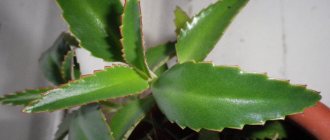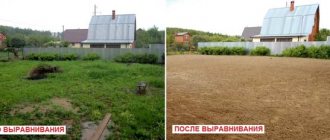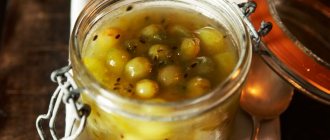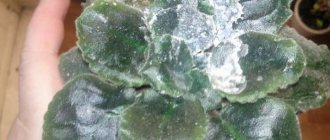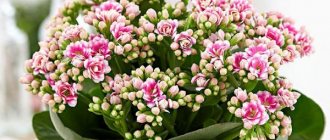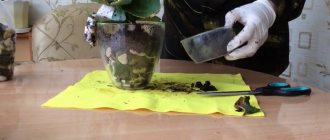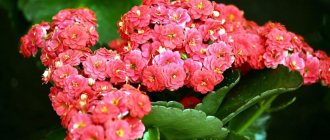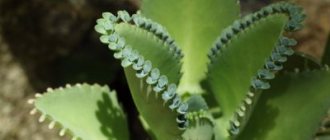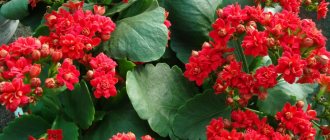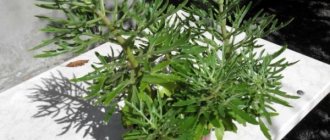- August 20, 2018
- Houseplants
- Alexander Nedashkovsky
Today, flower growers grow a wide variety of Kalanchoe varieties at home. The ornamental plant has medicinal properties. In addition, it has a beautiful appearance. Reproduction of Kalanchoe is not difficult even for inexperienced gardeners. This is probably why the plant is so common in our apartments.
Plant varieties
Throughout history, Kalanchoe has received many names - room doctor, tree of life, home healer... Our grandmothers always had this plant on their windows. Currently, there are many different species of this beautiful flower, including flowering representatives. They are the ones who are most popular. In nature, there are a total of more than 200 varieties of Kalanchoe. Only a few of them are grown at home. All of them are easy to care for and reproduce.
Kalanchoe can safely be classified as an unpretentious flower. The plants belong to the Crassulaceae family. Its homeland is the tropics, so the flowers are accustomed to long stays in wet and dry conditions. At favorable times, the leaves of the plant accumulate moisture, which they gradually use for survival. The flower takes root well in any home and does not require frequent replanting or fertilizing, which makes caring for it much easier. The plant is very resistant to pests and diseases. Even if you did something wrong and your flower began to die, you can always divide it into cuttings, which take root very easily. Reproduction of Kalanchoe is a simple process. Almost every rooted plant turns into a healthy and full-fledged flower.
Medicinal properties
People have long been aware of the medicinal properties of Kalanchoe. It is for this reason that previously it could be found in any home. Not only the leaves, but also the stems are used for medicinal purposes. Kalanchoe is one of the few plants that purify indoor air and destroy germs, disinfecting the room. The flower copes well with the flu virus. If now we are accustomed to using pharmaceutical products for colds and runny noses, then previously Kalanchoe was considered the first assistant. You can use it to make cold drops. The juice of the plant is also useful for wiping the nasal mucosa.
Kalanchoe has a powerful anti-inflammatory effect. It has antibacterial, hemostatic and bactericidal properties. The plant copes well with wound healing, it removes harmful substances from the body and cleanses the blood.
The medicinal properties of the flower are based on the fact that it gives a surge of strength and vigor. It is believed that the presence of Kalanchoe in the house contributes to a friendly and favorable environment.
The medicinal properties of Kalanchoe are actively used in folk medicine. The leaves are mainly used, from which juice or pulp is obtained. The plant contains a large number of biologically active and healing substances, among them it is worth highlighting organic acids, flavonoids, tannins, mineral salts, vitamins, macro- and microelements. Kalanchoe juice is used for herpes, to boost immunity, and for physical fatigue. The plant is rich in vitamin C, and therefore is indispensable for vitamin deficiency. Kalanchoe juice is used as ear drops to treat warts, trophic ulcers, purulent wounds, and burns. For sore throat, dilute it with water and gargle with the resulting solution.
Lighting
One of the most unpretentious indoor plants is Kalanchoe. Care after purchasing a flower is so simple that even a novice amateur gardener can handle it. The plant can be placed almost anywhere in your home as it thrives in indirect light and partial shade. You can also place the flower in direct sunlight. But at the same time, its leaves will change color slightly. Ideally, you should choose western or eastern windows, where the lighting is moderate.
For flowering species, the south-eastern and eastern direction is more suitable. In winter, the plant will need additional lighting. If a flower does not have enough light, it stretches and weakens. The upper leaves may turn pale and the lower leaves may die.
Watering Kalanchoe
Very often, beginners do not know how to properly water Kalanchoe. The plant accumulates liquid in the foliage. Therefore, he is not afraid of a period of drought. For example, the plant will not dry out if you leave for a while. But overwatering has a detrimental effect on the flower. In this case, it is not the amount of water that plays the main role, but another factor. When watering, the earthen ball must be well moistened. But later the excess water must be drained. In order not to overdo it with watering, it is worth developing the correct regime. To do this, it is necessary to moisten the soil after it has completely dried in the pot. Water procedures can be performed more frequently only in the summer heat. In winter, on the contrary, it is necessary to water the plant no more than once every 10-14 days. If the soil moisture is excessive, its roots will begin to rot. In addition, excessive humidity promotes the development of fungal diseases and mold.
In principle, Kalanchoe does not need to be sprayed. In winter, high humidity is dangerous for the plant. But at the same time, the flower periodically needs to be rid of dust accumulated on the foliage. To do this, you can bathe Kalanchoe in the shower or wipe the leaves with a damp sponge.
Kalanchoe - home care
Lighting
For normal growth, any place in the house that receives even a little sunlight is suitable. The plant grows well in partial shade or in diffuse sunlight.
When exposed to direct sunlight, the color of the leaves along the edges will change, they become reddish.
The ideal place in the house would be an east or west window
, with not very intense lighting. Blooming Kalanchoe prefers an eastern or south-eastern window.
During Kalanchoe flowering in spring and autumn, additional lighting will be needed.
Insufficient light causes plants to stretch out
, the upper leaves turn pale and the lower ones die.
Return to contents
Temperature
The plant tolerates temperature changes calmly. Therefore, starting from 10 degrees, it can be taken out into the fresh air. During the summer-autumn period, the plant can be left on the balcony.
The plant tolerates heat in the summer months well, but it is necessary to increase the frequency of watering.
The optimal temperature is considered to be: 23-25 degrees in summer, 12-16 degrees in winter
.
Watering
Kalanchoe accumulates moisture in its leaves and withstands drought or, for example, your absence. Plants are afraid of stagnant water.
Watering must be done abundantly to wet the entire lump of earth, but the remaining moisture must be drained.
Decide for yourself the correct frequency of watering; the earthen ball should dry out between waterings.
More often, watering is carried out in the summer heat; in winter, the interval between waterings is 10-14 days.
If you flood the plants, the roots will begin to rot, and various rots and fungi will appear.
Return to contents
Humidity
At home, Kalanchoe does not need spraying. It is especially dangerous to spray in winter. If the leaves are covered in dust, the best way to get rid of it is to wipe it with a damp cloth or, alternatively, wash it in the shower.
Trimming
In order for plants to bloom, they must be pruned radically. Trim the flower stalks as low as possible so that the remaining parts do not rot.
All bad looking and old parts of the plant must be removed. Young and strong shoots, after pruning, are suitable for propagation.
In summer, pinch off the tops to form side shoots and protect the plant from growing.
Video - Pinching decorative Kalanchoe
Top dressing
About once a month, Kalanchoe needs to be fed using fertilizers for succulents.
Complex fertilizers are used for flowering Kalanchoe
, otherwise the plant will not bloom.
Attention:
an excess of fertilizers is dangerous for Kalanchoe.
When feeding, it is better to dilute half the dose or a third according to the instructions of the drug used. Do not fertilize in winter.
Return to contents
Reproduction
Kalanchoe is a fast-growing plant and therefore reproduces easily.
For reproduction
Young shoots that remain after pruning or are cut specifically for propagation are suitable.
Shoots are approximately 10-12 cm long. 4-6 lower leaves are removed from them and planted at this depth in a pot with loose, fertile soil.
Roots will appear from the axils of the torn lower leaves in the ground. After planting, compact the soil around the shoot and water along the edges of the pot (so that the shoot in the ground wilts a little, do all other watering as usual, over the entire surface).
There is no need to cover the plant during propagation. Place the pot in a warm place with partial shade.
Return to contents
Transfer
Plants require annual replanting at the end of March
.
Adult plants can be replanted every 3 years
or sprinkled with fertile soil, provided that the roots do not protrude beyond the boundaries of the pot. Transplantation can also be done after flowering.
To replant, you need to select a pot 2-3 cm larger in diameter than the previous one. Carefully remove the flower when replanting so as not to damage the plant.
Pests
Among the pests that can attack Kalanchoe are scale insects, spider mites and mealybugs.
Mealybug
remove with a wet cloth soaked in alcohol.
In the fight against scale insects and ticks
Treatment with insecticides will help.
A good remedy is Fitovera
, it does not harm humans or pets.
Return to contents
Video - KALANCHOE. ALL ABOUT CARE
Proper pruning
For some plant varieties, pruning is an essential part of care. This is especially true for flowering species. How to prune Kalanchoe? The pruning procedure must be drastic. The flower stalks are cut off completely, leaving no extra parts. Very often, flowering greatly weakens the plant. In this case, you will have to cut off all the bad looking and old parts of the flower. At the same time, young and strong shoots can be cut off and used for propagation of Kalanchoe. In summer, flower growers recommend pinching off the top so that new side shoots appear. If this is not done, the plant will stretch.
How to prune a Kalanchoe that does not bloom? Even non-flowering forms require periodic pruning. The plant usually grows in height quickly. A too huge flower clutters up the space, so it is necessary to cut off some of the branches and the crown so that the bush grows wider. The resulting cuttings can be used for rooting. Pruning allows you to rejuvenate the plant. Young bushes look more aesthetically pleasing and beautiful.
Different methods of reproduction
Kalanchoe is a plant that reproduces very easily. You can get new flowers in a variety of ways. The process of flower propagation is so simple that anyone can handle it. Plant propagation is carried out by children, seeds, stem and leaf cuttings, and offspring. Any method always gives good results. To propagate Kalanchoe by leaf, you can even use fallen old leaves, which take root incredibly easily.
Some varieties of the plant reproduce by children. Small daughter sprouts form on the leaves of Kalanchoe. Children look very much like adult plants. They have small leaves and roots. Adult succulents most often shed such buds themselves, which easily take root in the mother pot. Later they can be transplanted into another container. If you find formed shoots on the leaves, you can safely break them off and plant them in fertile soil.
Propagation by leaves can be carried out at any time of the year. A cut adult leaf is planted in a pot with a moist substrate. It is covered with a jar or glass on top. The leaf takes root in just a few days. Soon it will become an independent plant. Sometimes part of a leaf is used for propagation. It is buried in the ground and after some time a young plant develops from it.
Peculiarities of reproduction of different types of Kalanchoe
Caring for Kalanchoe is very simple. To do this, you just need to create conditions suitable for flowering. If the plant blooms, then the care is correct.
After the plant has flowered, its branches are pruned to obtain planting material. The tactics for caring for the material are determined based on the type of reproduction. But all types have common conditions for rapid reproduction.
You need to use a mixture of humus and leaf soil. It is advisable to add peat and sand in a ratio of 5:1. It is allowed to use store-bought soil mixtures for cacti. To make drainage, you need to place expanded clay on the bottom of the pot.
Propagation by cuttings
The simplest and most popular way to propagate Kalanchoe is by cuttings. It is relevant at any time of the year. For planting, you can use any twig that accidentally breaks off from the plant. This often happens during the process of flower transplantation. It is necessary to choose strong shoots as cuttings. They can be of any length, but it is worth shortening them to 6-8 centimeters. Typically, the tops of shoots are used for propagation.
They are cut and placed in a jar of water until roots appear, after which the young plants are planted in separate pots. Shoots can also be immediately planted in a moist substrate. They quickly take root in the nutrient mixture. The apical cuttings produce beautiful young plants.
Reproduction of some varieties of Kalanchoe
The distinctive features of a particular variety of Kalanchoe play an important role in the methods of reproduction. Medicinal Degremona and Cirrus, as well as Tubeflower can be propagated by cuttings, children, suckers, leaves.
To propagate the Blossfeld and Mangina varieties, in addition to the above options, the seed method is used. And, what is very important, the varietal characteristics are preserved.
Felt Kalanchoe is easily propagated by both leaf and stem cuttings, and by seed, and for the paniculate-flowered variety, the method using axillary buds is convenient.
Other methods of reproduction
Sometimes Kalanchoe is propagated by offspring of the mother plant. To stimulate the process, it is necessary to pinch the tops of the stems, after which young shoots appear next to the old flower. This method can be used only after flowering. After the young plants have grown a little, they can be transplanted into another pot.
Some varieties of the flower shed their leaves after flowering, after which buds of new shoots appear in the axils. In appearance they resemble heads of cabbage. After they have formed a 1-2 centimeter stem, they can be cut with a blade and planted in the substrate. The buds take root within a week, after which active plant growth begins.
Kalanchoe can be propagated by seeds. In early spring, they are sown in moist soil and pressed down with hands. The soil is sprayed from above and covered with glass. Periodically, the soil must be ventilated and sprayed with a spray bottle. After the first shoots appear, the film or glass is removed forever. After some time, the grown seedlings dive. Young plants are planted in separate pots.
Kalanchoe from seeds
Sowing of seeds is carried out in April or May. This method is used if it is necessary to obtain many new species specimens. Varietal Kalanchoes are usually propagated vegetatively in order to preserve the characteristics of the parent plants.
Seeds are sown on the surface of the peat-sand mixture without planting them deeply. They try to maintain a distance between them of 3–4 cm. The soil mixture is moistened with a spray bottle, covered with film on top and placed in a warm place with a temperature of 22–24 degrees above zero. The film is regularly lifted and ventilated, shaking off condensation.
The seedlings do not take long to appear and appear from the ground in about a week. Remove the cover and remember to moisten it regularly. After 2–3 weeks, the seedlings are planted in small separate pots. It is important that they do not turn out to be too spacious, “in reserve” - the succulent will build up the root system without adding to the growth of the above-ground part. Kalanchoe tomentosa, Mangina and Blossfeld are propagated by seed.
Replanting Kalanchoe
How to transplant Kalanchoe into another pot? This question arises sooner or later before every gardener. It is recommended to replant young plants annually. Older people - once every two to three years. The procedure must be carried out after flowering.
To replant, you need to purchase soil for Kalanchoe. At home, you can prepare the soil yourself, but the finished substrate contains all the nutrients necessary for the plant. The flower is removed from the container in such a way as not to damage the root system. To facilitate the procedure, the plant must be watered beforehand. The earthen ball along with the root system is placed on the drainage layer in a new pot. The voids around are filled with substrate. The planted plant is watered and then mulched with small pebbles. This will help reduce moisture loss.
Breeding period for Kalanchoe
Before propagating Kalanchoe, you need to familiarize yourself with the characteristics of the flower. It is characterized by thickened fibrous roots, fleshy stems, and succulent leaves. The arrangement of leaves on the stem is spiral. The shape and surface of each species is different: with a smooth edge, feathery or jagged. It also differs in the size of the leaf plate. The flowers are small, four-petaled. The flower stalks themselves are formed mainly at the top of the plant, less often in the leaf axil.
Kalanchoe - a medicinal plant at home
There are several ways to propagate Kalanchoe. They all come down to two types - vegetative and seed. The breeding period is determined by the chosen method:
- plant seeds are sown in the soil at the end of winter;
- the vegetative method can be used regardless of the time of year;
- babies appear on brood buds throughout the year, so their rooting can be done even in the winter;
- Cuttings, leaf planting material or layering are best harvested in the spring.
Important! It is not recommended to use flowering Kalanchoe for propagation. The winter period when the flower is dormant is also excluded.
The breeding period of Kalanchoe depends on the breeding method
How to properly propagate Kalanchoe so that in the future the plant develops correctly and is not subject to various kinds of diseases:
- Kalanchoe cuttings are performed with a sharp knife. It is pre-wiped with alcohol or heated over a fire, which reduces the likelihood of the plant becoming infected with bacteria and fungi;
- the cutting is selected up to 10 cm long. The shoot must be very young. Its rooting will be faster;
- the shoots are first dried for two days to avoid rotting of the base of the cutting;
- when propagating by leaf plates, make sure that the leaves are planted in the ground in a horizontal position;
- To germinate roots, use only boiled water, which is replaced every two days;
- It is advisable to plant in ceramic pots. In plastic containers, shoots take root less well;
- water carefully so that water does not fall on the plant, and in small doses.
Choosing a pot
When replanting, take a new pot a few centimeters larger than the previous one. Typically, containers from 12 to 18 centimeters in diameter are used. The size of the pot depends on the type of Kalanchoe. You should not purchase containers that are too large, since they will have a lot of space for the root system, which will grow, but the plant will not bloom. You can create entire compositions from flowering Kalanchoes. Ceramic pots are ideal for planting; flowers can breathe in them. And moisture leaves the soil naturally. Before planting Kalanchoe in a new flowerpot, it is necessary to treat its walls and bottom with hot water and a solution of potassium permanganate.
Preparing for landing
For Kalanchoe, it is better to select plastic containers that have not been used before. There should be a sufficient number of drainage holes at the bottom of the container. The size of the pot depends entirely on the size of the plant. For example, it is better to transplant a young shoot into a container 2 cm larger in diameter.
If we are talking about adult specimens, then the size of the new pot should be such that the old one fits into it quite tightly. The fact is that the plant will bloom only in a fairly tight container. A large container will stimulate the development of the root system and foliage to the detriment of flowering. The pot must be disinfected before use.
For this purpose you can use:
- concentrated manganese solution;
- laundry soap;
- furatsilin solution (1 tablet per 50 ml of boiling water);
- boric acid.
Important! Do not plant plants in wet containers. After disinfecting treatments, rinsing and other manipulations with liquids, be sure to dry the container in the sun.
Soil for Kalanchoe is prepared by mixing in a ratio of 4:2:1:
- peat;
- soddy leaf soil;
- sand.
Soil disinfection is best done using a hot solution of wood ash. It will not only disinfect it, but also nourish it with useful minerals. It is prepared at the rate of 1 tbsp. l. ash per 1 liter of water. The mixture must be boiled, poured hot into the soil and mixed thoroughly. Next, the soil is dried so that by the time of planting it is sufficiently moist, but does not stick to your hands.
Drainage should also be prepared for Kalanchoe. It is best to mix expanded clay with perlite in a ratio of 1:0.5 and add 20% of the total mass of sphagnum moss. Before use, the mixture is poured with boiling water, then dried and crushed.
Possible problems
Why do Kalanchoe leaves turn yellow? This problem occurs for various reasons:
- Insufficient lighting can cause yellowing of the foliage. If a flower is exposed to less than 12 hours of light per day, it may begin to wilt.
- Kalanchoe is an unpretentious flower. It can grow in a wide range of temperatures. But when the temperature drops to +10 degrees, the foliage begins to turn yellow.
- Kalanchoe dries out most often due to insufficient humidity levels. The cause may be heating devices in winter. In this case, the plant must be sprayed daily with a spray bottle.
- Overwatering can cause a flower to wilt. The flower must be watered with settled water. In winter, the amount of moisture should be minimal.
If you have not been able to figure out why the plant dries out and turns yellow, then you will have to transplant it into a new container by adding fresh soil. During replanting, it is necessary to check the roots and remove rotten parts. Pay attention to whether there are pests on the plant. The root system can be treated with charcoal or other protective preparations. Kalanchoe is an unpretentious plant that does not require special conditions. The flower can safely be called a long-liver.
Instead of an afterword
Kalanchoe is a universal plant that can be grown in any apartment. Ease of reproduction and simple care make it very popular. If previously our grandmothers grew non-flowering species, now flowering forms are incredibly popular. Abundant bright flowering in the cold season can delight gardeners for a long time. Due to the ease of propagation and rapid growth, the plant can be planted even in open ground in the warm season. You can root cuttings or plant a mother plant in your garden plot. Over the summer, young flowers will turn into beautiful bushes. And the mother plant will delight you with lush greenery and good growth.
